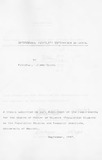| dc.description.abstract | This study examines indirect techniques of estimating
intercensal fertility levels in Kenya. Parameters,Crude birth
Birth Rate, Total Fertility Rate, Net Reproduction Rate, Gross
Reproduction Rate and the Mean Age at Birth for the 1969 to
1979 intercensal period are estimated at National, provincial
and district levels. These are estimated by applying several
standard indirect procedures and models of estimating fertility
which are also compared. To obtain estimates that reflect
effects on a hypothetical cohort of a prolonged exposure to
vital rates in operation during the 1969 to 1979 intercensal
period, the standard procedures are adjusted by the additive
synthetic adjustment technlque. The age-specific growth rate
adjustment technique, functioning as both an indirect procedure
and an adjustment technique, is also used to estimate fertility
parameters that reflect exposure of a hypothetical age cohort
to past rates of attrition and entry into the population. IhlS
also reflects, among other things, the effect of vital rates
and migration rates prevailing during the 1969 to 1979 intercensal
period. The techniques have also been applied in evaluation
of data quality.
Chapter One introduces the study by stating the problem,
objectives of the study, significance of the study, literature
on historical and technical backgrouds of techniques, sources
and quality of data and definitions of parameters. Chapter Two
discusses P!F ratio methods, namely the Brass and Coale-
Trussell P!F ratio methods. Chapter Three examines techniques
that base estimations on only reported lifetime fertility,
2
namely the Coale-Demeny P3 /P2 formula, and Brass-Rachad's
4
P2(P4!P3) formula. Chapter Four Describes and discusses the
relational Gompertz model. Chapter Five discusses the agespecific
growth rate adjustment technique. Chapter Six gives a
summary of the findings, conclussions and recommendations. This
is followed by references/bibliography and appendices.
National, provincial and district level analysis shows
that indirect techniques that estimate intercensal fertility
levels in the presence of trends donot perform as well as those
that rely only on lifetime fertility data. Also evident is the
disparity between data on births reported in the twelve months
peceeding each census and data reported by the same women
regarding the number of children ever born. Synthesising data
to refer to hypothetical cohorts theoreticaly minimises the
effects of intercensal changes in vital rates and patterns of
error on fertility estimates for the same period. But, still,
additive synthetic adjustment technique amplifies the margin of
error created by such changes. Also, the age-specific growth
rate adjustment technique is reliable only if changes in the
composition of age cohorts are adequately adjusted for. The
latter is especially sensitive to effects of migration. | en |

